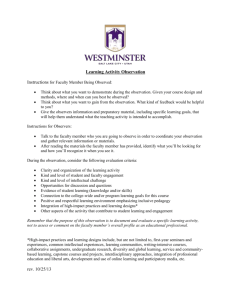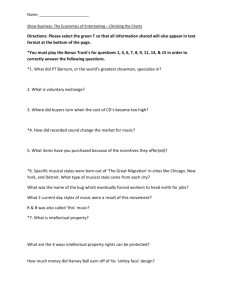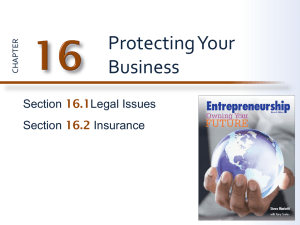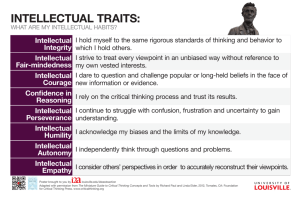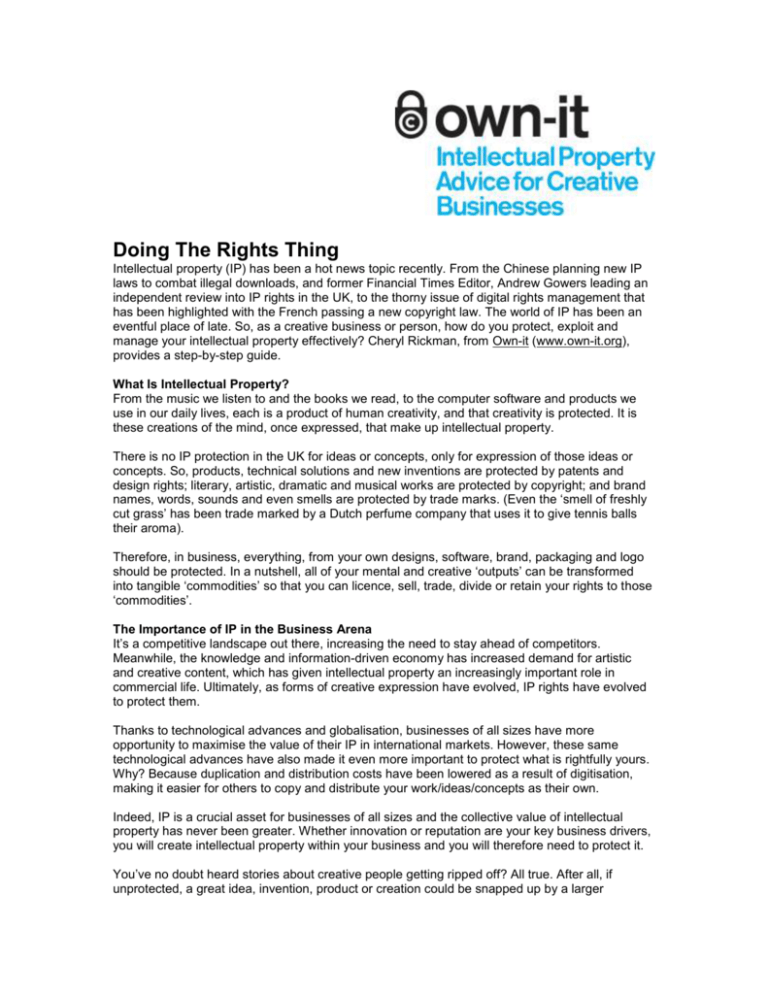
Doing The Rights Thing
Intellectual property (IP) has been a hot news topic recently. From the Chinese planning new IP
laws to combat illegal downloads, and former Financial Times Editor, Andrew Gowers leading an
independent review into IP rights in the UK, to the thorny issue of digital rights management that
has been highlighted with the French passing a new copyright law. The world of IP has been an
eventful place of late. So, as a creative business or person, how do you protect, exploit and
manage your intellectual property effectively? Cheryl Rickman, from Own-it (www.own-it.org),
provides a step-by-step guide.
What Is Intellectual Property?
From the music we listen to and the books we read, to the computer software and products we
use in our daily lives, each is a product of human creativity, and that creativity is protected. It is
these creations of the mind, once expressed, that make up intellectual property.
There is no IP protection in the UK for ideas or concepts, only for expression of those ideas or
concepts. So, products, technical solutions and new inventions are protected by patents and
design rights; literary, artistic, dramatic and musical works are protected by copyright; and brand
names, words, sounds and even smells are protected by trade marks. (Even the ‘smell of freshly
cut grass’ has been trade marked by a Dutch perfume company that uses it to give tennis balls
their aroma).
Therefore, in business, everything, from your own designs, software, brand, packaging and logo
should be protected. In a nutshell, all of your mental and creative ‘outputs’ can be transformed
into tangible ‘commodities’ so that you can licence, sell, trade, divide or retain your rights to those
‘commodities’.
The Importance of IP in the Business Arena
It’s a competitive landscape out there, increasing the need to stay ahead of competitors.
Meanwhile, the knowledge and information-driven economy has increased demand for artistic
and creative content, which has given intellectual property an increasingly important role in
commercial life. Ultimately, as forms of creative expression have evolved, IP rights have evolved
to protect them.
Thanks to technological advances and globalisation, businesses of all sizes have more
opportunity to maximise the value of their IP in international markets. However, these same
technological advances have also made it even more important to protect what is rightfully yours.
Why? Because duplication and distribution costs have been lowered as a result of digitisation,
making it easier for others to copy and distribute your work/ideas/concepts as their own.
Indeed, IP is a crucial asset for businesses of all sizes and the collective value of intellectual
property has never been greater. Whether innovation or reputation are your key business drivers,
you will create intellectual property within your business and you will therefore need to protect it.
You’ve no doubt heard stories about creative people getting ripped off? All true. After all, if
unprotected, a great idea, invention, product or creation could be snapped up by a larger
business that is in a better position financially to commercialise, leaving the creator of the
intellectual property with no financial or moral reward for their efforts.
So, as well as making sure your own creative efforts are rewarded and protected, by properly
managing your IP, you can:
Gain the competitive edge by carving out a strong position for your brand, products and
services and prevent your competitors from copying you.
Increase your company’s market value, both before and after flotation. If you have
various relevant patents in place and have registered your trade mark, you’ll find it easier
to access venture capital and will be much more investor-friendly as a result.
Create a strong credible brand and corporate identity to persuade more customers to do
business with you.
Avoid expensive litigation from those rights you may have infringed had you not fully
understood IP.
Prevent others from trading off your own creative endeavours.
What Can Be Protected And How So?
Patents protect inventions, design rights protect 2D and 3D designs and copyright protects
dramatic, artistic, literary and musical works.
PATENTS: A patent is a legal document that grants the owner absolute rights (a monopoly) to
produce, use or sell the patented product, and prevent anyone else using their innovation or
invention. The document also describes the full technical workings of the invention in detail (so a
patent protects ownership and usage, but not privacy).
Patent protection is granted for a period of 20 years from the date the patent application was filed.
On expiration, the invention then enters the public domain and is available for others to exploit
commercially. Patents provide recognition and financial reward and inspire future generations of
inventors.
COPYRIGHT: Creators of original artistic, musical and literary works can protect their work with
copyright. Copyright covers all forms of creative works, from books, paintings and films, to
choreography, sound recordings and computer code, software, graphics and other digital media.
Copyright gives creators the exclusive rights to use or authorise others to use their work. The
author, or freelancer or employer owns the copyright, rather than the publisher or employee,
unless agreed otherwise. And copyright protection gives the owners rights to prevent copying,
publication, broadcasting, distribution or hiring).
There is no need to register your copyright. Rather, copyright exists automatically as soon as an
original piece of qualifying work is created. So, as soon as you write, upload or create your work,
it is instantly protected by copyright.
However, it’s essential that you keep evidence of the evolution of the work. You can do this by
including the symbol, date and your signature on any preparatory work such as design
sketches, documentation and research material. This log of the work’s development will be
invaluable if you need to enforce your IP and prove you own the copyright.
Literary, dramatic and artistic works have immediate copyright protection that lasts until 70 years
after the death of the creator. Computer generated works and performer’s rights last until 50
years after the creator’s death, while typographical arrangements are given 25 years protection.
This is currently a thorny issue as the first wave of rock 'n' roll recordings, starting with Elvis, are
about to go out of copyright in Europe. Not surprisingly, the UK music industry wants the current
50-year time limit extended.
Worth noting:
1. Employers own copyright, employees do not own rights to anything they’ve created in
accordance with employment.
2. If you are freelance, you own the copyright, not the client, unless you have a contract for
a service that assigns copyright to the commissioner of the work. So, usually, freelance
or commissioned work will belong to the author of the work, unless there is an agreement
to the contrary, (i.e. in a contract for service).
TRADE MARKS: A trade mark is a “badge of origin” by which the public can distinguish the
products and services of one business from another (i.e. logo, slogan, brand name). A trade mark
can be protected by registering it and a registerable mark must be distinctive and can consist of
words, letters, numbers, images, drawings, symbols, smells and sounds, or a combination of
these.
To be registerable, the mark must be distinctive and not identical or similar to a previously
registered mark that applies to the same or similar goods or services. A trade mark registration
must be renewed after 10 years.
A trademark that is registered gives the owner the exclusive right to use it or authorise someone
else to use it. Protection usually lasts for 7-10 years or more and can be renewed. Registered
trade marks are enforceable under trade mark law and use the ® symbol. Conversely,
unregistered trade marks are not enforceable under trade mark law and use the TM symbol.
DESIGN RIGHTS: Designs can be protected too. Design rights can be registered or unregistered
and rights exist for 2D and 3D designs, but don’t protect the functionality of a design, only the
‘ornamental or aesthetic aspect’, i.e. the appearance of a product resulting from its features, lines,
contours, colours, shape, texture, materials or ornamentation.
The design must be novel and have individual character. If successful, protection can potentially
last for up to 25 years, renewable ever five years.
Unregistered design rights exist automatically, like with copyright, and this lasts for 15 years, but
must not be a common-place design.
Two important points for any budding designer to remember are:
1. Employers own design rights, employees do not own rights to anything they’ve created in
accordance with employment. Especially important if you want to take a concept from
your employment to market.
2. If pitching for a commission, it is the commissioner who owns the rights to the designs
because you have been contracted to provide the service for them. Ordinarily,
freelance/commissioned work copyright would belong to the author, but if you assign
copyright through a contract when providing the service, the person commissioning you
will own it. If in doubt, check who owns what.
MORAL RIGHTS: These are your rights to be identified as an author or creator of intellectual
property. You can waive your moral rights via a release form. Some entrepreneurs using research
students to help them develop products may ask that they waive their moral rights, or
broadcasters using footage of performances.
Managing your IP and Unlocking The Value Of Your Creativity
STEP-BY-STEP
STEP 1 – IDENTIFY YOUR INTELLECTUAL PROPERTY
List any creative ‘assets’ – your intellectual property, from your logo and company
name/brand, to your packaging design, products and software.
Check your designs, expressed ideas, concepts and creative works are new and original.
STEP 2 – PROTECT YOUR INTELLECTUAL PROPERTY
Put in place a simple confidentiality agreement with a client, potential manufacturers or
investors BEFORE you start negotiations. You can download free sample contracts from
www.own-it.org). A well drafted agreement will specify the type of information to be
protected, how long the duty of confidentiality is to last and to whom the information may
be disclosed.
Register designs, patents and trade marks, visit www.ipo.gov.uk.
Secure Internet domain names to safeguard your brand.
Agree terms and get everything in writing. When approaching manufacturers you should
strive to get various agreements in place, such as a confidentiality agreement, prototype
agreement (whereby the factory agrees to make a sample to your specifications), heads
of agreement and manufacturing agreement.
Catalogue everything that you have. Keep good records, including your sketches, notes,
drafts, diagrams, contracts, letters and e-mail communications. Strive to keep all work in
progress and a ‘design’ or working story.
Assert your rights. Mark the author/publisher or creators name on all copies of your work,
along with the date and country. © (Name of owner) (Year of creation).
Put registered design rights and other IP renewal dates in your diary. Never forget IP
rights or domain name renewals.
STEP 3 – EXPLOIT YOUR INTELLECTUAL PROPERTY
Managing and exploiting your biggest asset, your IP, will help your business make more money –
to do this you need to:
Ensure any designs, trade marks and patents you register or apply for are the same as
those you intend to market.
Inform people that you have a registered design or trademark to increase your credibility
and make people aware of your rights. For example, you should put your design rights
number on any packaging and if you have a registered trade mark.
Maximise returns by licensing your rights either as a whole or separately to exploit your
IP in different territories or different forms – this way you hold onto your rights whilst
making money from them.
Charge an assignment fee if the client wants the rights, always seek external advice
before assignment (such as the size of the fee and appropriateness of this decision).
Licence your IP (either exclusively or non-exclusively). You can licence your rights
exclusively to the licensee only, or non-exclusively to the licensee and anyone else you
choose to licence to. You can licence reproduction or distribution rights, rental or lending
rights. Consider what you are licensing (eg. your trademark, copyright, design rights) in
what format (exclusively or non-exclusively) and how long for (eg. are the terms of the
licence for a fixed term, perpetual or terminal) and finally, where in the world you are
licensing to?
Figure out whether you require royalties, licence fees or both. (Royalty payments
generally vary between 4 and 14%, dependent on the type of creative work/industry).
Negotiate fair terms. This is the period where you spend time bargaining to work out a
deal. Next comes the contracting part, which involves formulating the details to create a
binding agreement.
Make sure you are given equitable remuneration for your work. For example if you
produce sound recordings, you should be paid royalties by the MCPS PRS alliance. And,
if you have written a book, you should receive lending royalties as well as royalties from
your publisher.
Use a Creative Commons licence if you want to control and share your IP. You can
choose to allow reproductions of your work but not for commercial purposes or other
methods of use, so some rights are reserved instead of all. Visit
www.creativecommons.org for more information.
STEP 4 – ENFORCE YOUR INTELLECTUAL PROPERTY
Even the big boys can experience problems enforcing their IP. DVD piracy costs the film industry
hugely, just as illegal music downloading costs the music industry. So how can you enforce your
IP effectively?
Monitor what competitors and new entrants to your market are doing. Get news alerts,
subscribe to industry news, keep an eye on the UK Intellectual Property Office site
(www.ipo.gov.uk) site and pay attention to new trade marks being advertised. If any
infringe yours you are able to contest them once they’ve been advertised.
Send standard cease and desist letters if you find anyone infringing your IP rights. A
lawyer can help draw up an effective letter to send out and advise you on the best course
of action.
So what of the future of Intellectual Property? Recent high-profile cases such as Apple Computer
vs. Apple Corps and the MCPS and PRS launch a licensing scheme for music podcasters, it
seems that the topic of IP isn’t about to fall off the radar anytime soon.
Resources
Here’s a bunch of useful resources to help you stay on top of your IP and maximise its value.
www.own-it.org
Own-it’s free services range from basic IP information to advanced legal support for London’s
creative businesses, through online resources and specialist seminars, contracts, workshops,
and, free IP clinics for one-to-one advice from IP lawyers. All of this is provided free of charge by
experts who’ve been there and done it. View the latest events at www.own-it.org/events.
www.alcs.co.uk
The Authors’ Licensing and Collecting Society Limited (ALCS) is the UK rights management
society for writers.
www.ipo.gov.uk
Provides information and advice on copyright issues, plus patents, registered designs and trade
mark info.
www.creatorsrights.org.uk
The Creators' Rights Alliance brings together the major organisations representing copyright
creators and content providers throughout the media -- particularly, television, radio and the
press.
www.dacs.org.uk
Design and Artists Copyright Society (DACS)
www.ideas21.co.uk
Of particular interest for inventors and product/industrial designers, Ideas21 is network devoted to
invention and innovation, and is supported by government, industry and private organisations.
www.invent.org.uk
Institute of Patentees & Inventors
www.royaltiesreunited.co.uk
Royalties Reunited. If you're a session musician, recording artist or backing vocalist, Royalties
Reunited is the place for you to find out if you are owed money - and claim it. Registration is
completely free.
This work is licensed under a Creative Commons Attribution-NonCommercial-NoDerivs 2.0
England & Wales License.
View the license at http://creativecommons.org/licenses/by-nc-nd/2.0/uk/.



